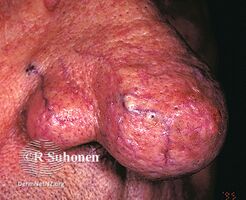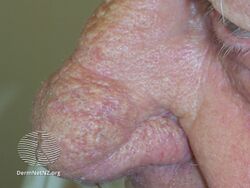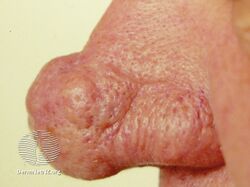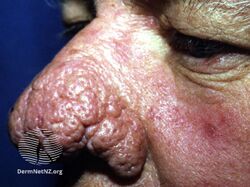Rhinophyma
| Rhinophyma | |
|---|---|
 | |
| An Old Man and His Grandson, by Domenico Ghirlandaio | |
| Specialty | Dermatology, ENT surgery |
| Symptoms | Enlarged and bulbous nose[1][2] |
| Complications | Basal cell cancer, stigma[1] |
| Usual onset | Older males[3] |
| Causes | Unclear[1] |
| Risk factors | Rosacea[1] |
| Diagnostic method | Examination[3] |
| Differential diagnosis | Basal cell cancer, sarcoidosis, lymphoma, leishmaniasis[3] |
| Treatment | Medications, procedures[1] |
| Medication | Metronidazole, azelaic acid, tetracycline antibiotics, isotretinoin[1] |
| Frequency | 0.1%[4] |
Rhinophyma is a condition that results in an enlarged and bulbous nose.[1][2] The skin can be red, have visible blood vessels, or prominent pores.[1] It can result in psychological stress and trouble breathing through the nose.[3] Other areas including chin, ears, eyelids, and forehead may be similarly affected.[1]
The cause is not clear.[1] Usually it occurs as a complication of rosacea, though may occur following acne.[3][1] It has mistakenly been link with alcoholism.[2] The underlying mechanism involves increased growth of sebaceous glands and connective tissue.[3] Diagnosis is based on examination.[3]
Treatment may include creams such as metronidazole or azelaic acid; or tetracycline antibiotics or isotretinoin by mouth.[1] A number of procedures such as cryotherapy, dermabrasion, and laser therapy may be used.[1] These procedures result in at least short term benefit.[3] Basal cell cancer can occur within a rhinophyma.[1]
One study found about 0.1% of people are affected.[4] The condition is most common in white males over the age of 50.[3] It is uncommon in Asians and Africans.[3] The condition has been described since the 1400.[3] Other terms for the condition include "whiskey nose", "gin blossom", and "potato nose".[3] The condition is frequently associated with stigma.[3]
Signs and symptoms
Rhinophyma is characterised by prominent pores and a fibrous thickening of the nose, sometimes with papules.[5] It is associated with the common skin condition rosacea and it can be classified clinically into 5 grades of increasing severity.[6]
-
Grade 1
-
Grade 2
-
Grade 3
-
Advanced
-
Advanced
Complications
Tissue thickening may come to cause airway obstruction and impede breathing.[3]
Rhynophyma cause psychological distress due to its effect on one's personal appearance[7][3] and social perceptions of a link with alcoholism.[3]
Causes
Rhinophyma develops in certain individuals with an unknown predisposition from long-standing rosacea which has progressed to a severe form.[3]
Although rhinophyma has been commonly presumed to be linked to alcoholism, a direct causal relationship between the condition and excessive alcohol consumption has not been substantiated.[3] Alcohol may cause increased flushing in those affected.[8]
Pathophysiology
Rhinophyma develops in some individuals after long-standing rosacea that has progressed to acne rosacea.[3]
Rosacea usually commences in people between the age of 20-30 years. Rosacea begins with facial flushing (pre-rosacea). The nasal skin then thickens and hypervascularises, leading to persistent erythema (vascular rosacea). Papules and pustules then develop, marking the beginning of acne (inflammatory) rosacea. A subset of those affected by acne rosacea go on to develop rhinophyma. Chronic infection is common as the thickened sebaceous fluid traps bacteria.[3]
Rhinophyma is characterised by hypertrophy of nasal skin, with hyperplasia and fibrosis of the sebaceous glands and connective tissue. The nasal tip and alae are preferentially affected by the hypertrophy, and the lower portion of the nose is predominately affected. The underlying bony structure is not affected.[3]
The exact pathophysiological mechanism underlying the development of rosacea and rhinophyma is unknown, but a combination of neurovascular and immune disturbance is thought to be involved, causing inflammation, fibrosis, and vascularisation.[3]
Males
Even though females are more often affected by acne rosacea, they seldom go on to develop rhinophyma. It is thought that androgenic factors predispose men to develop rhynophyma.[3]
Diagnosis
Rhinophyma is diagnosed clinically based on presentation (erythema, telangiectasias, and nasal skin hypertrophy). Diagnosis is confirmed by histology.[3]
Treatment

Treatment may include creams such as metronidazole, azelaic acid, or retinoids; or tetracycline antibiotics or isotretinoin by mouth.[1] A number of procedures such as cryotherapy, dermabrasion, and laser therapy may be used.[1]
Epidemiology
Rhynophyma usually occurs in white men older than 50 years. Males are 5x to 30x as likely to be affected as females.[3]
Asian Americans and African Americans are only rarely affected by the condition.[3]
Society and culture
Colloquial names for the condition include "whiskey nose", "gin blossom", and "potato nose". The condition has often been presumed to be a result of alcoholism (even though it remains unclear whether alcohol actually contributes to the development of rhynophyma) which has led to stigmatisation of people with the condition. In film, villainous characters have been portrayed as having rhynophyma, notably the evil queen in the animated film Snow White and the Seven Dwarfs.[3] Among those people known to have had the disease was the American banker J.P. Morgan.
References
- ↑ 1.00 1.01 1.02 1.03 1.04 1.05 1.06 1.07 1.08 1.09 1.10 1.11 1.12 1.13 1.14 1.15 "Rhinophyma". dermnetnz.org. DermNet NZ. Archived from the original on 26 May 2021. Retrieved 10 June 2021.
- ↑ 2.0 2.1 2.2 Cohen AF, Tiemstra JD (2002). "Diagnosis and treatment of rosacea". J Am Board Fam Pract. 15 (3): 214–7. PMID 12038728. Archived from the original on 2019-12-15. Retrieved 2021-05-21.
- ↑ 3.00 3.01 3.02 3.03 3.04 3.05 3.06 3.07 3.08 3.09 3.10 3.11 3.12 3.13 3.14 3.15 3.16 3.17 3.18 3.19 3.20 3.21 3.22 3.23 3.24 3.25 3.26 Dick, Mary K.; Patel, Bhupendra C. (2020), "Rhinophyma", StatPearls, Treasure Island (FL): StatPearls Publishing, PMID 31335093, archived from the original on 2021-05-20, retrieved 2020-12-24
- ↑ 4.0 4.1 Rook's textbook of dermatology (Ninth ed.). Chichester, West Sussex: Wiley. 2016. p. 91-3. ISBN 9781118441176.
- ↑ "Rosacea". Dermnetnz.org. Archived from the original on 2016-07-25. Retrieved 2021-05-21.
- ↑ Wang, Yan, MD, PhD, Allen, Philip, MB, BS. Giant Rhinophyma. Adv Anat Pathol. 2020;27(6):422-424. doi:10.1097/PAP.0000000000000282.
- ↑ "Rhinophyma". Archived from the original on 16 March 2011. Retrieved 24 March 2011.
- ↑ Fitzpatrick, James E.; Morelli, Joseph G. (4 August 2015). Dermatology Secrets Plus (5th ed.). Elsevier Health Sciences. p. 511. ISBN 9780323313551. Archived from the original on 29 August 2021. Retrieved 10 May 2016.
External links
| Classification | |
|---|---|
| External resources |




